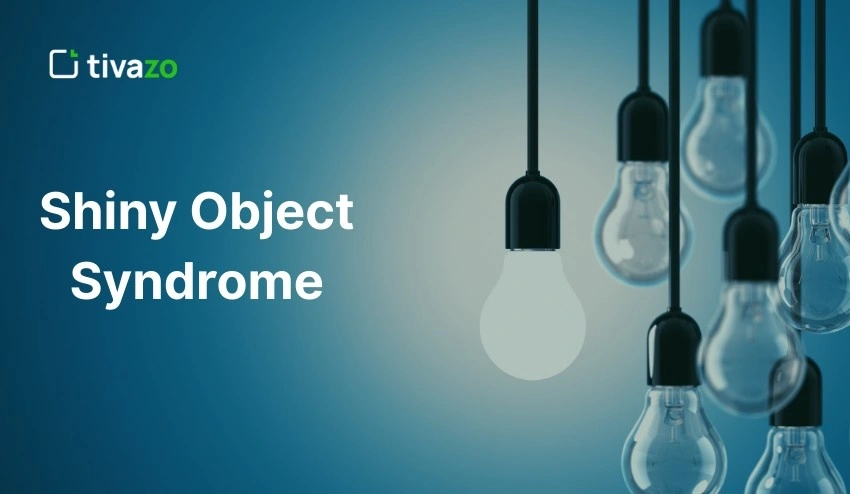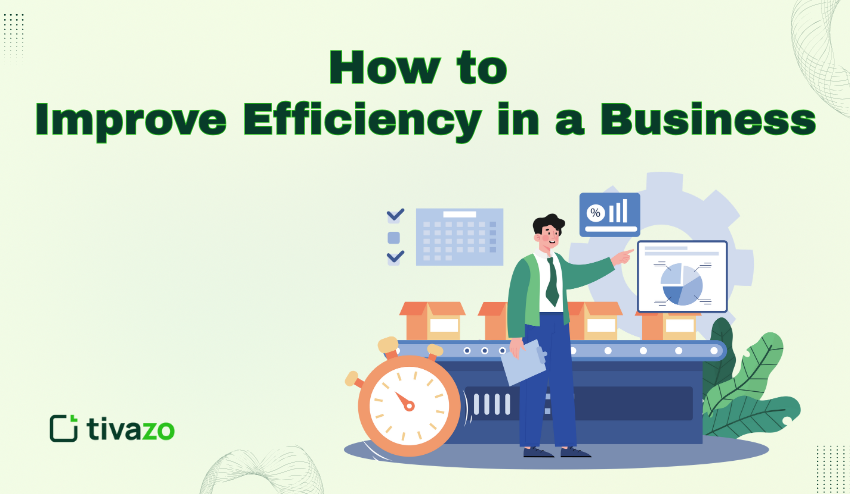In 2025, the most intelligent companies will stop just cost-cutting and start the process of turning lost value back into the business through energy management. They will optimally use their energy and avoid wasted energy due to rising energy costs, tightening sustainability regulations, and increasing customer constituents.
The good news is that energy management is not just about reducing the total carbon footprint. This process also creates profitability, efficiency, and resilience. In this guide, you will find 5 tested strategies, including insights, tools, and real-world examples, that will allow your company to change energy from a liability to an opportunity.
Key Highlights:
- Definition of energy management
- Importance of energy management
- Energy Management Strategies for Success
- Key Benefits of Energy Management
- Common Mistakes to Avoid in Energy Management
- Future of Energy Management
- Tools and Software to Simplify Energy Management
- How Tivazo Can Help You Master Energy Management
What do you mean by energy management?
Energy Management is the act of monitoring, controlling, and improving how energy is delivered and consumed in an organization. The energy management process exemplifies tracking energy usage like tracking time, identifying excess energy, and applying improvements in cost reductions, efficiency, and supporting sustainability goals.
Why Energy Management Matters in 2025?
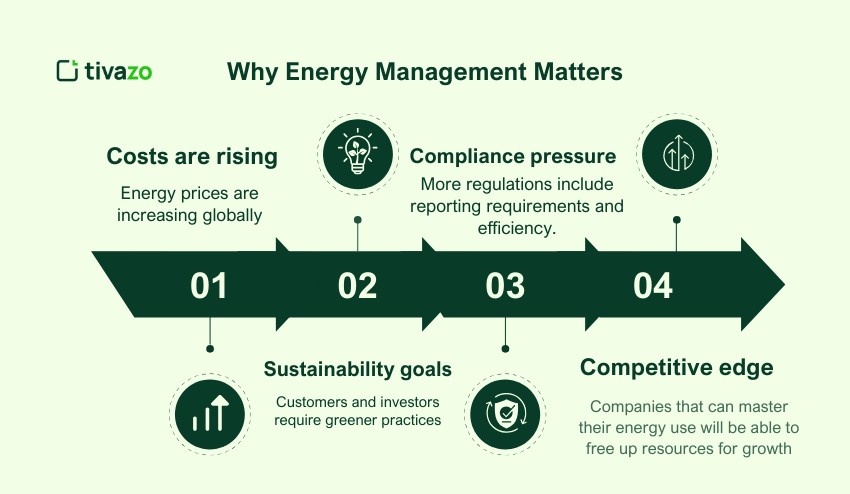
Energy management is becoming more important than ever in 2025 as businesses continue to experience increasing pressures to reduce financial costs, greenhouse gases, and comply with more regulations. By taking control of how energy is used, businesses can reduce costs and meet sustainability expectations, comply with changing legislation, and have a competitive advantage over their peers.
- Costs are rising: Energy prices are increasing globally.
- Sustainability goals: Customers and investors require greener practices.
- Compliance pressure: More regulations include reporting requirements and efficiency.
- Competitive edge: Companies that can master their energy use will be able to free up resources for growth
5 Proven Energy Management Strategies for Success
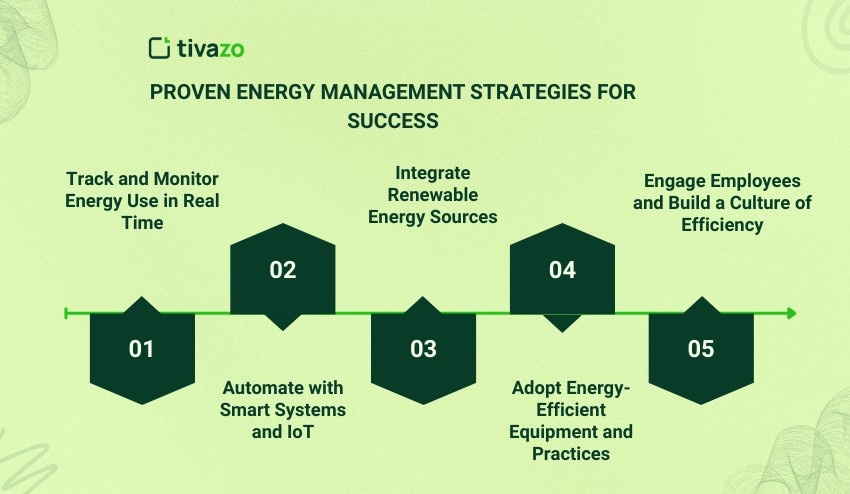
1. Track and Monitor Energy Use in Real Time
Energy management is a data-driven process. New smart meters, IoT sensors, and dashboards provide visibility into exactly when, where, and how energy is consumed. You can identify hidden waste, unearth seasonal patterns, and review inefficiencies in usage that would otherwise be lost in the background of your unconscious monthly bill.
- Use smart meters for timely, accurate monitoring
- Use IoT sensors to monitor the usage of a specific piece of equipment or a defined zone
- Review your usage at peak hours to find high-cost times
2. Automate with Smart Systems and IoT
Today’s energy demand is too dynamic for manual monitoring, control and human intervention. IoT-enabled automation can respond nearly instantaneously to changes: automatically dimming lights when spaces are turned off, adjusting HVAC according to occupancy levels, and powering down machinery when it is idle.
- Dim or off lights in vacant spaces
- Adjust HVAC levels based on occupancy levels.
- Power down idle machinery or equipment.
- Manage controls through IoT dashboards.
3. Integrate Renewable Energy Sources
Energy prices of fossil fuels are unpredictable, while renewables offer energy price stability and long term control. Integrating solar panels, wind turbines, or hybrid systems not only impacts the utility bill, but also fulfills corporate sustainability goals.
- Add solar panels or mini wind models
- Add hybrid systems that combine renewable and fossil fuels
- Store excess energy in batteries to cover peak use
- Reduce dependence on fossil fuels and stabilize energy prices
4. Adopt Energy-Efficient Equipment and Practices
New energy-efficient updates are sometimes under-advertised or unknown. A small change, such as swapping out an incandescent light bulb for an LED, which uses 75% less energy than an incandescent. A new HVAC system can potentially 20 – 40% less heating and cooling costs. In some instances, replacing an energy-hogging piece of machinery in a factory and replacing it with a new energy-efficient version would have substantial savings.
- Switch to LED lighting throughout the building
- Upgrade to up-to-date energy-efficient HVAC systems
- Replace inefficient equipment with energy-efficient models
- Shut down equipment that is not being actively used
5. Engage Employees and Build a Culture of Efficiency
The most robust energy programs should include technology and people. Employees who connect their individual contributions in energy efficiency to reducing waste can create a ripple effect throughout the business. Effective training, awareness campaigns, and gamification rewards programs (an office “energy-saving” competition with a team winner) can help build meaningful cultural change.
- Provide employee training on an energy-smart culture
- Run awareness campaigns to explain energy goals
- Reward teams or departments for energy savings
Key Benefits of Energy Management for Businesses
Effective energy management does not only mean lower costs for the business; it has the potential to reframe the way a business is organized and operated. By monitoring and managing energy in a meaningful way, businesses can reduce waste, improve efficiency, and demonstrate a commitment to a sustainable future. The benefits of these aspirations do not just stop at the business bottom line, but have positive impacts on regulatory compliance, customer trust, and a business’s overall competitive advantage in the marketplace.
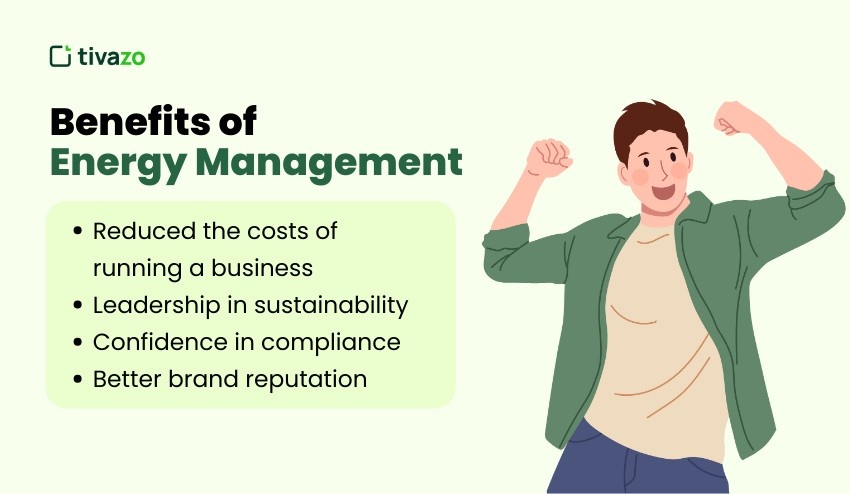
- Reduced costs of running a business (direct savings on bills).
- Leadership in sustainability (reduced carbon footprint).
- Confidence in compliance (stay ahead of ESG mandates).
- Better brand reputation (customers reward greener companies).
Common Mistakes to Avoid in Energy Management
It can be easy for even the best energy management plans to flounder on little details. Many businesses that adopt energy management initiatives often overlook critical details that end up wasting their time or reducing savings, or just the engagement of employees in their energy management initiatives. Recognizing common mistakes helps organizations develop a stronger, more effective energy program that will produce measurable results.
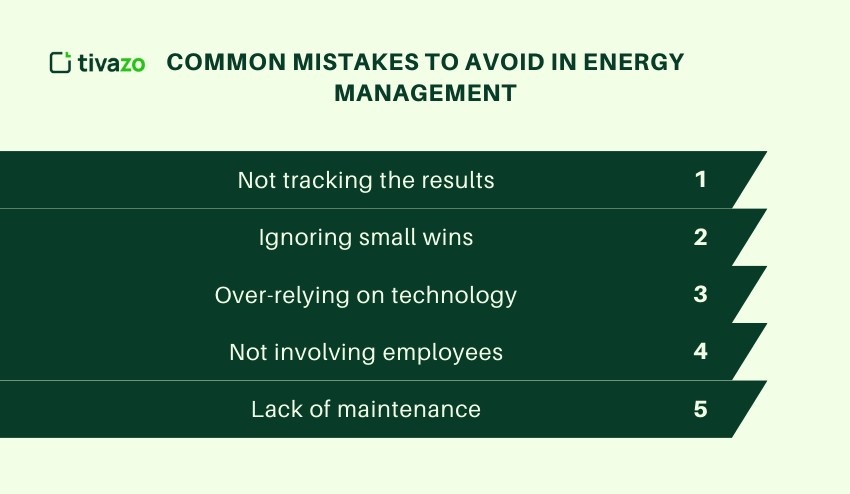
- Not tracking the results: You can’t measure what you can’t manage, and without tracking your energy use, you are wasting opportunities as an organization.
- Ignoring small wins: Small inefficiencies, such as leaks or outdated lighting, may seem like they won’t materially contribute to energy use, but those pesky inefficiencies can add up over time.
- Over-relying on technology: No technology is going to solve energy management challenges; people and culture are what lead to sustained efficiencies.
- Not involving employees: The lack of employee engagement will lead to energy solutions that will not stick.
- Lack of maintenance: If you do not take care of the maintenance of equipment, it will operate inefficiently and waste energy and money.
Future of Energy Management: Trends to Watch in 2026
Energy management is always changing and evolving, and 2026 will see the emergence of many new technologies and changes to business priorities. Businesses that are open to change will be the ones that have advanced tools and strategies to manage energy that will increase efficiency, reduce costs, and deliver on sustainability targets. Knowing what the major trends are for 2026 can only position your business in the right direction for future investments and competitiveness.
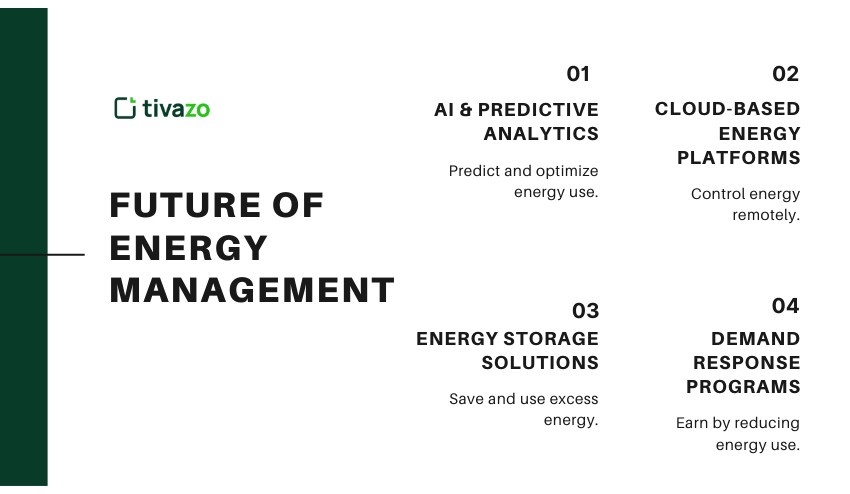
- AI & Predictive Analytics: Leverage AI to predict energy demand, identify inefficiencies, and maximize use before they occur.
- Cloud-Based Energy Platforms: Naturally, someone has suddenly invented an “energy cloud-connected centralised system that contains the logic to monitor and control the energy consumption at any time and from anywhere in the world.
- Energy Storage Solutions: Scatter-free batteries and storage solutions allow you to store surplus energy and provide it during peak use times, meeting demand and lessening dependence on expensive grid energy.
- Demand Response Programs: Enroll in programs that pay businesses to curtail energy as needed to offset demand, saving you money and earning you credits.
Energy Management vs. Energy Efficiency: What’s the Difference?
Even though these terms are sometimes used interchangeably, energy management and energy efficiency are different but related concepts.
- Energy Efficiency is using less energy to do the same task. For instance, if an organization is replacing all their incandescent light bulbs with LED lighting, or if they are using an energy-saving HVAC system to cool or heat their building, effectively this means they are reducing their energy consumption but the task of lighting or cooling ,or heating remains the same. Efficiency is concerned with practices and products that save energy at the point of use.
- Energy Management is the strategy of monitoring, controlling, and improving a business or facility’s entire energy system. Energy management involves measuring consumption, analyzing consumption, planning upgrades (potentially new energy-efficient tools), and integrating technologies such as automation, smart tools or renewable energy. Management is looking at a strategy and systems within the organization that optimize energy use.
In other words – think of it like this – the efficiency is the “how” and the management is the “what and when”. Both are equally important – efficiency alone will not capture all opportunities and management alone, without efficient tools, will waste energy savings going forward.
Tools and Software to Simplify Energy Management
To support energy manageability and effectiveness, many organizations have started using Energy Management Systems (EMS) and productivity platforms. Most of these systems help track energy usage, analyze poor usage, and help with energy management strategy execution.
Popular tools and software include:
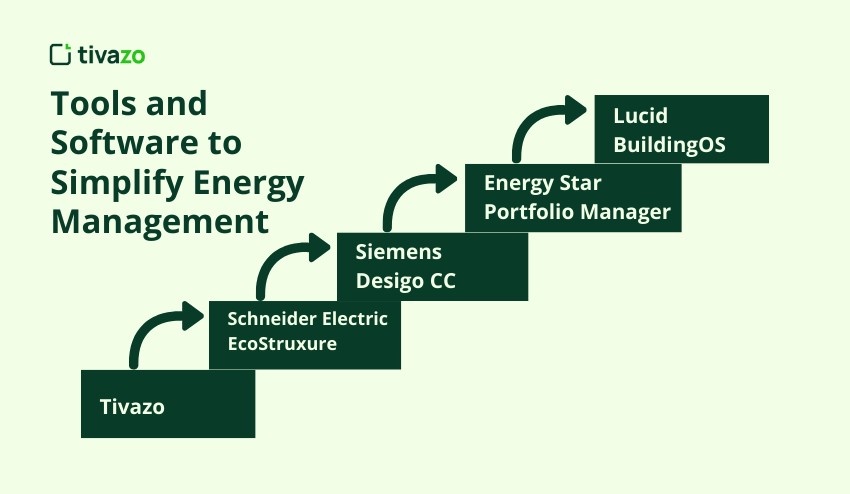
- Tivazo: Team Time tracking and operational efficiency.
- Schneider Electric EcoStruxure: energy management for buildings and facilities that efficiently manages the whole building from a comprehensive view.
- Siemens Desigo CC: Energy Management and analytics within building/property management.
- Energy Star Portfolio Manager: track and benchmark building energy performance.
- Lucid BuildingOS: cloud-based and focuses on real-time energy monitoring and reporting.
The Role of Employee Engagement in Energy Management
Human factors are often one of the most underrated aspects of energy efficiency. Technology will not produce savings if the employees operating it are not engaged, motivated, or aware of ‘energy-smart’ behaviours.
Ways employees influence energy management:
- Participating in energy awareness training and programs,
- Practicing behaviours such as powering down devices that are not in use or being aware of when they might be running a workflow unnecessarily,
- Providing feedback and ideas to improve efficiency,
- Engaging in incentive programs or taking part in team challenges that encourage reducing consumption,
- Fostering a community of sustainability.
Engaging with employees leads to greater gain for organisation efficiency, waste, and fosters accountability and sustainability that underpins all other aspects of energy management.
Conclusion
In 2026 energy management is not optional; it is a strategic advantage that will help you transform your business. By measuring energy consumption, automating energy systems, using integrated renewable sources, investing in new equipment, and creating a culture of improvement, companies can save money, improve the operation of the business and improve their brand/company reputation. When energy is managed better, it can stop being a cost center and become a true driver for growth, sustainably, and competitive differentiation. There is no better time than now to begin — as applying these processes and tools like Tivazo, allows business to achieve sustainable efficiency and competitive viability for years to come.
